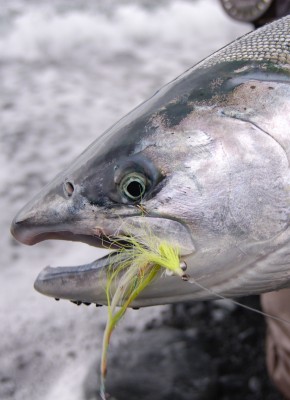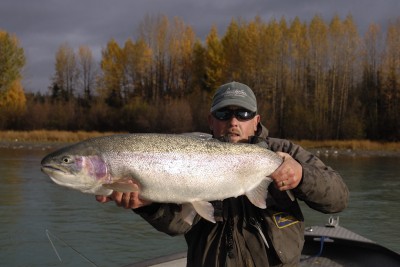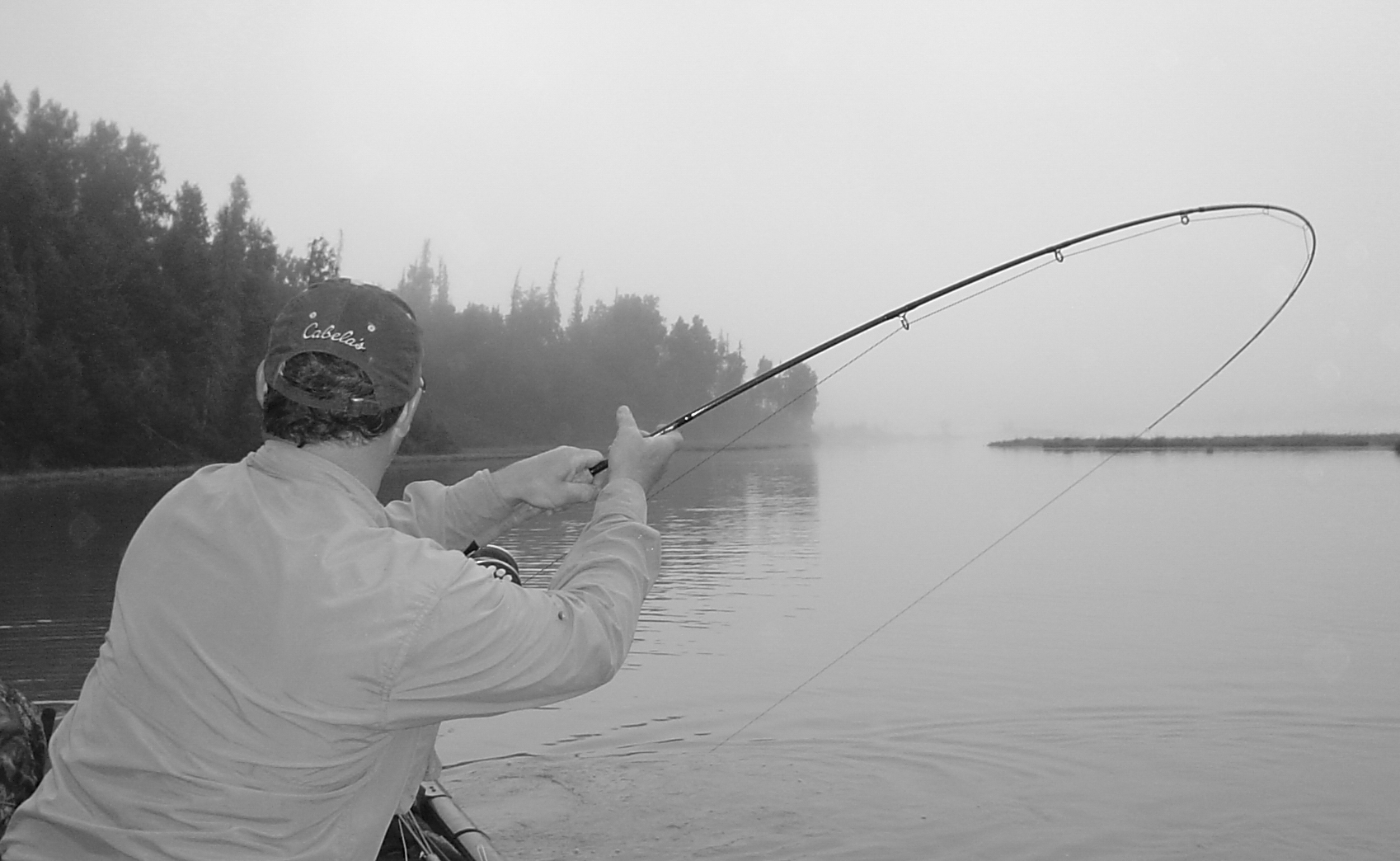
26 Jan Alaska Fly Fishing
Alaska Fly Fishing on the Kenai Peninsula is world class. The boundless opportunities to throw a line are as numerous as the fish you will pursue. One general footnote of caution is that Fly Fishing in Alaska is unlike most fly-fishing you have previously experienced or may subsequently expect. The water can be big, technical and the fish are almost exclusively wild. The path to proven success is largely water and species specific. That is, each strain of salmon or population of resident rainbow trout is unique to where it lives and a specialized presentation will be required to gain their attention.
King Salmon
Smaller Kenai Peninsula Rivers:
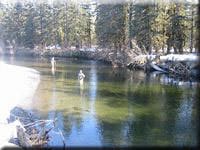 Aside from the Kenai, The Peninsula and the West Side of Cook Inlet offer numerous target destinations for big kings on the fly. Just south of the Kenai is the smaller Kasilof River and this is very popular among fly anglers. The water is big, though not quite the size of the Kenai, especially in May and June when water levels are low. Farther south on the Kenai Peninsula, you will find several considerably smaller rivers, namely the Ninilchik, Deep Creek, and the Anchor River. These tea-colored, non-glacial streams host short-lived but strong returns of kings and their size makes them very friendly for fly-fishing. These rivers open for king salmon on Memorial Day weekend and are only open on weekends only (Fri. Sat and Sun) until mid to late June. All of these rivers have individual rules so please consult current regulations before wetting a fly:
Aside from the Kenai, The Peninsula and the West Side of Cook Inlet offer numerous target destinations for big kings on the fly. Just south of the Kenai is the smaller Kasilof River and this is very popular among fly anglers. The water is big, though not quite the size of the Kenai, especially in May and June when water levels are low. Farther south on the Kenai Peninsula, you will find several considerably smaller rivers, namely the Ninilchik, Deep Creek, and the Anchor River. These tea-colored, non-glacial streams host short-lived but strong returns of kings and their size makes them very friendly for fly-fishing. These rivers open for king salmon on Memorial Day weekend and are only open on weekends only (Fri. Sat and Sun) until mid to late June. All of these rivers have individual rules so please consult current regulations before wetting a fly:
The Kenai:
Fly Fishing for King salmon is limited on the Kenai River for a number of reasons but is certainly a viable pursuit. Since the Kenai is such a large river, effectively presenting a fly to its world record size Chinook is very difficult. It is only effective in a few select locations, many of which are privately owned and inaccessible. The lack of prime fishing water does not discourage some fly anglers from tempting the Kenai’s big water and certainly the law of average does reward the very good and the very lucky.
Fly Out King Fishing:
Stepping into a plane and visiting a remote fishing location is by far your best bet for taming large Alaska kings on a fly. Since utilizing a float plane and/or helicopter can assure you first water and optimal numbers of fish, your success rate is sure to skyrocket. Most fly out king fishing is done on non-glacial rivers where you could throw a fly across almost every hole. Our primary fly-out destinations for king salmon include the Chuitna River on the West Side of Cook Inlet, and several rivers in the Bristol Bay Region and on Kodiak Island. Due to the added flight costs, all of these trips are considerably more expensive than guided fishing on the Kenai Peninsula but for the true fly fishing enthusiast, the superior water, lack of people and numbers of fish, well warrant the added cost.
Gear:
A fast 8-10 wt. fly rod will be required for Alaska King salmon. Keep in mind the size of the river and the fish you are likely to catch when selecting your weapon. Since the size of most kings in Alaska will exceed 20lbs., a 10 weight is probably the best all around choice. Large Arbor reels are nice for quick retrieves and work well on small waters but they do not hold much backing. When fishing larger rivers like the Kenai, you will need a stout drag and lots of line. Both floating and sinking line have their place in Alaska waters. Many prefer to load their mono with split shot to find the bottom fastest while others will use heavy sink tips to take their fly into the king’s lair. The fly you select will vary depending on water conditions but generally kings are aggressive toward full-bodied leech patterns, woolly buggers, and a variety of colorful, flashy steamers. Egg patterns in variety of sizes and colors also do the trick.
Sockeye Salmon
Almost all sport caught sockeye are taken with a fly so fly-fishing for this strain of Alaska Salmon is very popular. Since sockeye or red salmon are plankton eaters in the ocean they are not prone to chasing their prey and subsequently are not regarded as aggressive toward flies or lures. They migrate upriver close to shore, making them very accessible for bank anglers. The most effective technique is to flip your fly into the current at an upstream angle and lead it toward shore with the tip of your rod low to the water. With the number of fish moving upstream, your leader and ultimately your fly, will end up drifting into one of their mouths. These are the finest fighters, pound for pound, of all Alaska Salmon. The debate over how your fly got into the corner of the fish’ mouth is ongoing but no one seem to disagree on how fun they are to catch and how tasty they are to eat.
Fly Fishing for sockeye is primarily done on the Russian River, the Kenai River and the Kasilof River as well as a number of fly out destinations on the West Side of Cook Inlet.
Gear:
Since most of the sockeye fishing is done in fast water with strong current, a fly rod with considerable backbone is important. A 7 weight is probably the lightest you can use, while most would prefer a 9 weight. Floating or sinking line is largely irrelevant, as you will only be flipping far enough from shore to use your tippet or leader. Many will fill their fly reel with heavy mono (20-30 lb. Test) to assure maximum leverage and to save losing an expensive fly line if you hook one of these silvery torpedoes in the back.
A number of flies will work for sockeye but a few do stand out as being the most effective for hooking these fish in the mouth. One is a Coho Fly, which essentially is a plain deer hair streamer tied in a wide range of colors. Another popular fly is a teeny nymph named for its creator Jim Teeny. These small drab nymphs are merely a hook and a bit of hackle or steamer material and very little tail. They too come in a variety of colors but are generally much smaller and subtler than Coho Flies. Simple yarn flies also work well for sockeye.
Silver Salmon
Silver salmon can be found in almost every Kenai Peninsula drainage as well as several rivers on the West side of Cook Inlet. They are a favorite among fly anglers due to their aggressive nature, hard fights and the type of water they frequent. Silvers have a tendency to travel the path of least resistance and they will often group up in areas with little or no current. This makes fly presentation very effective and the result is usually A LOT of action. Even though the Kenai is a great place to fly fish for silvers, it is far from fly friendly water due its size. The Kenai is best fished from a boat so it is not the optimal place for throwing flies. Smaller Peninsula Rivers such as the Russian (a tributary of the upper Kenai near Cooper Landing) Ninilchik or the Anchor will likely hold the best fly fishing opportunities for Coho. The finest fly-fishing for silver salmon in South Central Alaska and perhaps the entire state is just a 20-minute flight by floatplane to the West Side of Cook Inlet. Big River Lake, the Kustatan River, the Chuitna River, among others, are all world-class fly-fishing destinations. The fish in these drainages are particularly aggressive toward a wide variety of both wet and dry flies. They are present in large numbers and catch rates are very high.
Gear:
Since silvers are mostly caught in areas with little or no current, a 6-8-weight rod matched with a large arbor reel and floating line is a perfect combination. Silvers like many different flies under a wide range of conditions but some proven Coho killers include the various egg-sucking leeches, tinsel flash flies and other full-bodied, colorful streamers.
Rainbow Trout, Dolly Varden, Grayling
Some of the best fly-fishing that the Kenai Peninsula has to offer is for resident Rainbow trout and Dolly Varden. These year-round natives are found in a variety of waters, with the most prevalent and popular being the Kenai River. The Average Kenai Rainbow is 18-24 inches and fish over ten pounds or 30 inches are common. The section of the Kenai River between Kenai and Skilak Lake is the most popular among fly anglers due to the many gravel bars and wading opportunities. The section of the river below Skilak Lake is also very popular and consistently produces the most and largest rainbow trout and Dolly Varden. Due to the size of the river in this section, most fly-fishing is done from the boat using considerable weight to combat the strong current.
Rainbow Trout and Dolly Varden are also available in many of the smaller rivers that feed the Kenai and also on many other Kenai Peninsula rivers and streams. They are also well stocked in many area lakes.
Grayling are found in a number of higher elevation streams and lakes including Quartz Creek and Crescent and Carter Lakes. These fish are regularly taken on dry flies. Fly Anglers can hike to many of the best lakes and streams and floatplanes can also provide excellent access to more remote grayling waters.
Gear:
A 4-6 weight fly rod is perfect for most Alaska Rainbow Trout, Dolly Varden and Grayling fishing. Most river fishing requires floating line and an indicator to ensure an effective dead drift. Flesh patterns and single eggs (both beads and glo-bugs) are the only flies worth using when fishing the Kenai and many of its tributaries. The fish are only feeding on protein rich salmon by-product and closely replicating this food source is essential for regular success. Painting beads and altering the color and size flesh patterns is a must as environmental conditions in the river change daily. In some of the very small streams or mountain lakes, some traditional wet and dry flies can be effective, particularly for high mountain grayling.
![Glassmaker_Chinook03[1]](https://www.mgfalaska.com/wp-content/uploads/glassmaker_chinook031.jpg)
